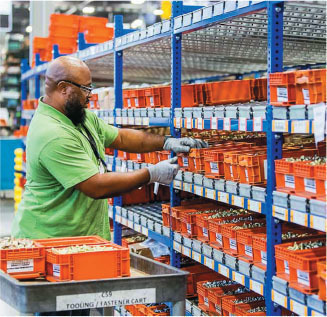The twisting, the bending, the lifting—it’s all part of a typical material handling job. But that job doesn’t have to be done without help. Ergonomic products, particularly those that help an associate lift or position items at the right height to prevent bending, are widely available. Improving the use and understanding of these products is at the forefront of the work of MHI’s Ergonomic Assist Systems and Equipment (EASE) Council.

UNEX’s Flow Cells are storage racks that can reduce reaching by putting needed components at a more ergonomically friendly level. Workers at Daimler Trucks Components & Logistics’ North Carolina facility use 40 FlowCell Workstations and 2,600 SpanTrack Lanes, giving workers an organized and dependable way to carry out assembly tasks.
“It’s pretty broad,” said Patrick Lippert, director of supply chain for MHI member Hamilton Caster and a member of the council. “It’s not just out in the shop, but also in our daily lives.” The goal, he said, is “products that help our work be safer, easier and less stressful on the body.”
That is a tall order, particularly when material handling requires a lot of repetitive motion. The federal Occupational Safety and Health Administration (OSHA) has recently begun cracking down on warehouses for what it deems ergonomic hazards. Some states have even more stringent requirements.
“Even with 20- or 30-pound boxes, turning your body and lifting on a repeat basis and is a huge issue,” said Mark Westphal, director of marketing for Schmalz and an EASE council member.
While ergonomic solutions are available for virtually every material handling job—including those in offices—warehouse use tends to focus on lifting aids and component placement.
All in the Lift
At Hamilton Caster, which makes industrial casters and wheels, a lift system can raise the crate and tilt it to the operator who is using a lathe to machine the wheels. “They can grab them from a safe and more ergonomic distance, so that they’re not bending over, and can lift them into the machines more easily,” Lippert said. Workers also have lifting belts to protect their backs.
“We take this very seriously, and workers do, too,” Lippert said. “They don’t want to get injured. It is a win-win because it helps when we can show that we don’t have work-related injuries.”
MHI member Schmalz, a manufacturer of vacuum-assisted lifts which pair with crane systems, offers both ergonomics and security, Westphal said. “Lifting with the tube evacuates air, which makes it go up or down. It’s easy to drive and there’s not a lot of jerking. Within 20 minutes, anyone can get the gist of it.”
Vacuum technology can be applied to robotics as well, he said. Customers will choose based largely on “the number of turns someone is doing,” Westphal said, and many will upgrade from the tube lifters to robotics after seeing the efficiencies gained.
MHI member UNEX’s Flow Cell, meanwhile, is “very popular in assembly and production lines,” said Megan Baker, UNEX’s director of marketing and EASE council member. FLOW Cells are storage racks that can reduce reaching by putting needed components at a more ergonomically friendly level. “All of them slot into this ergonomic framework because they are reducing the need for someone to bend and lift and potentially climb into a rack. They are very good at streamlining and reducing the strain that workers would receive from those motions.”
Time and Cost Savings
Lifting aids also can help reduce the need for “two-man” lifts. Westphal noticed a huge uptick at the start of the pandemic, when workers had to stay six feet apart. “People were asking, ‘How do I put less people in one working area?’” he said. “The pandemic changed the way that we all buy, and e-commerce centers have gone crazy with tube lifters that are portable.”
The lifters also are helpful in alleviating worker shortages by reducing the need for more than one worker on a heavier lift.
 MHI Solutions Improving Supply Chain Performance
MHI Solutions Improving Supply Chain Performance
